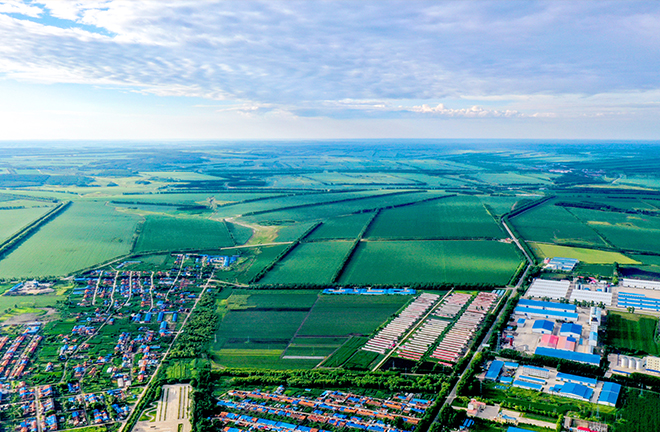Revitalization of northeast region plays a strategic role in national development

The farmland in Shuangshan County, Nenjiang City of Heilongjiang Province in Northeastern region. Photo: Yang Bo/CNS
Since the 18th CPC National Congress, the CPC Central Committee has placed a high premium on development of the Northeastern region. The 20th CPC National Congress further emphasized the importance of implementing the coordinated regional development strategy and achieving new breakthroughs in the full revitalization of the Northeast. It is thus urgent to thoroughly implement these major strategic plannings, made by the Party and the state, to make greater progress in the full revitalization of the Northeast.
The first step is to integrate development and security. As General Secretary of the CPC Central Committee Xi Jinping pointed out, the Northeastern region is a key industrial and agricultural base for the country. It plays a very important strategic role in safeguarding national defense security, food security, ecological security, energy security, and industrial security. The Northeast influences the big picture for national development.
It is thus necessary to strengthen synergy between Northeastern revitalization and the coordinated development of the Beijing-Tianjin-Hebei region, development of the Yangtze Economic Belt, construction of the Guangdong-Hong Kong-Macao Greater Bay Area, integrated development of the Yangtze River Delta, and high-quality development in the Yellow River basin. Security is the prerequisite for development, and development guarantees security. For the Northeastern region, security and development should be the central thread that runs through all sectors and the whole process of economic and social progress.
The second step is to shape a new industrial development pattern. The Northeast region is where equipment manufacturing, resources, energy, and other industries are highly agglomerated with a solid foundation for the real economy. While inspiring the digital economy’s potential and deepening understanding of information technology and intelligent technology, it is necessary to accelerate transformation and upgrading of traditional industries that are advantageous to the Northeast. Meanwhile, raw material industries based on petrochemicals, metallurgy, building materials, and deep processing industries comprise a large proportion of the industrial structure in the Northeast, which is greatly affected by fluctuations in international commodities’ prices and is also highly sensitive to economic cycles. Therefore, revitalization of the Northeast must prioritize overcoming sensitivity from industrial structures and focus on cultivating emerging industries, which feature new development modes and new business forms.
The third step is to utilize the “green” advantage. With fertile land, vast open areas, short frost-free periods, few pests, and limited diseases the Northeast possess innate advantages in developing high value-added green agriculture and favorable conditions for green development. To realize this, it is important to further promote the low-carbon transformation of modes of production and lifestyles. It is also necessary to optimize the land use structure, strengthen spatial planning, and further regulate land use. Other measures include keeping the skies blue by eliminating heavy pollution.
The fourth step is about building the region into a pivotal space for opening up and cooperation. Located in the central region of Northeast Asia, the Northeast of China has a crucial strategic position. Facing complicated domestic and international environments, the region should seize this historical opportunity by deeply integrating itself into construction of the Belt and Road Initiative and participate in regional cooperation within Northeast Asia. This requires policies and systems that are more conducive to opening up, cooperation, and alignment with internationally accepted economic and trade rules. Maritime and foreign-related judicial protection is also needed for an open, transparent, and predictable investment environment. We will also need to strengthen development of carriers for opening up, such as pilot free trade zones, comprehensive bonded zones, and comprehensive pilot zones for cross-border e-commerce. Moreover, the Northeastern region can further participate in construction of the China-Mongolia-Russia economic corridor and deepen its cooperation with Russia, Japan, South Korea, North Korea, and Mongolia. Furthermore, the Northeastern region can take advantage of its port and transport resources in the hinterland, to realize connectivity with railway lines in Mongolia, Russia, and Europe in order to form an integrated transport network.
Xie Di is a professor from the Economic Division at Liaoning University.
Edited by BAI LE

 PRINT
PRINT CLOSE
CLOSE